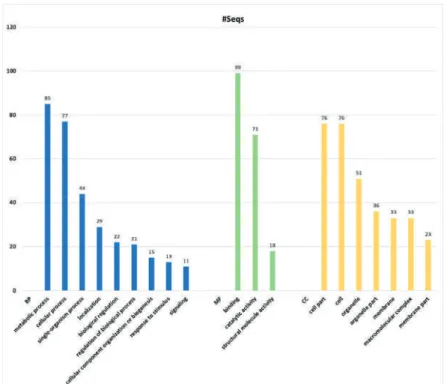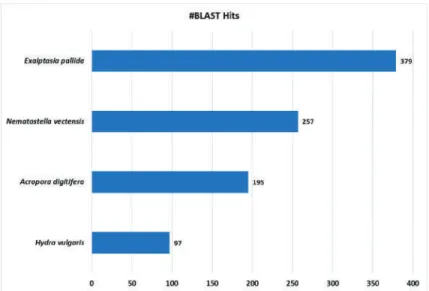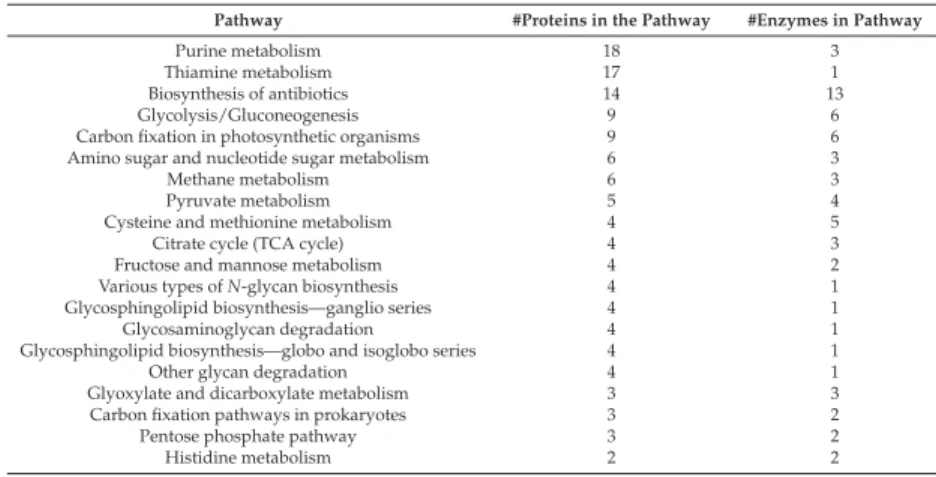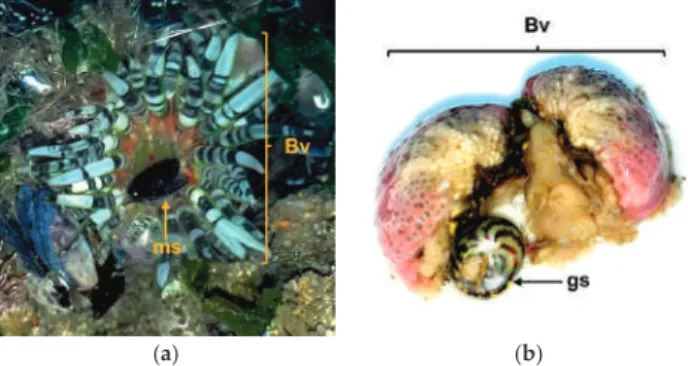The Jellyfish Rhizostoma pulmo (Cnidaria): Biochemical composition of ovaries and antibacterial lysozyme-like activity of the oocyte lysate. He is currently a member of the EuroMarine and JRC-EASIN European networks, as well as the chairman of the Academic Council in Biology at the University of Salento.
Proteomic Analyses of the Unexplored Sea Anemone Bunodactis verrucosa
- Introduction
- Results and Discussion
- Materials and Methods 1. Protein Extraction
- Conclusions
Each of the approximately 11,000 living species [6] possesses nematocysts [7], the organ specialized in the production, elimination and inoculation of toxins [8]. Peptide fingerprint of the neurotoxic fractions isolated from the secretions of sea anemones Stichodactyla helianthus and Bunodosoma granulifera.
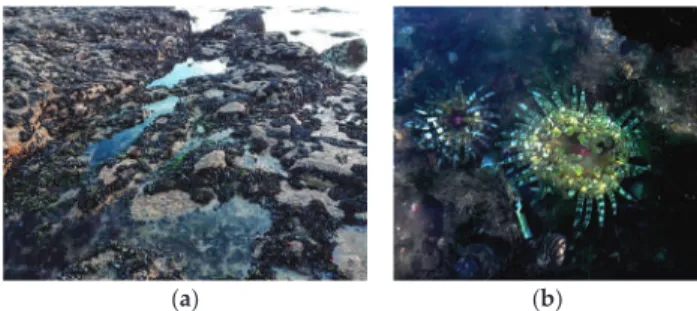
Barrel Jellyfish (Rhizostoma pulmo) as Source of Antioxidant Peptides
Materials and Methods
Trolox was used as a standard and was tested under the same sample conditions. The MTS cell viability assay was used to determine the effects of the extracted jellyfish compounds.
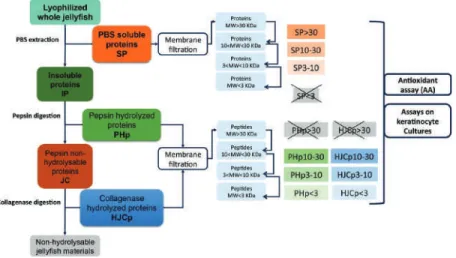
The Holo-Transcriptome of the Zoantharian Protopalythoa variabilis (Cnidaria: Anthozoa)
A Plentiful Source of Enzymes for Potential Application in Green Chemistry, Industrial and
Materials and Methods 1. Biological Sample
The RNA sequencing and contig assembly statistics are summarized in Supplementary Table S1. Species information of the selected annotations was extracted from the BLAST output files to discern taxonomic distribution. The annotations were then subjected to a generic GO-slim reduction, prior to Enzyme Commission codes (EC) and KEGG pathway mapping.
Annotation results generated during Blast2GO analysis were used to extract a list of transcripts with partial EC number. The tentacle transcriptome and venom proteome of the Pacific sea nettle, Chrysaora fuscescens (Cnidaria: Scyphozoa). Toxins 2016, 8, 102.
Stress-Induced Mucus Secretion and Its Composition by a Combination of Proteomics and Metabolomics of
Results
Three groups, namely 'tissue-enriched proteins', 'mucus-enriched proteins' and 'unchanged proteins' are shown. The horizontal axis indicates the rich factor, i.e. the proportion of the number of differentially expressed proteins vs. The color represents -log10(pvalue): Logarithmic conversion of Fisher exact test pvalue. E) Venn diagram of the extracellular proteins in mucus-enriched proteins.
The color represents-log10(pvalue): Logarithmic transformation of Fisher exact test pvalue. D) The 'ECM-receptor interaction' pathway was matched to the KEGG PATHWAY database where the increased proteins of mucus-enriched proteins are colored in red. Three sequences were successfully scanned with their similarities identified in mucus-enriched proteins of A.
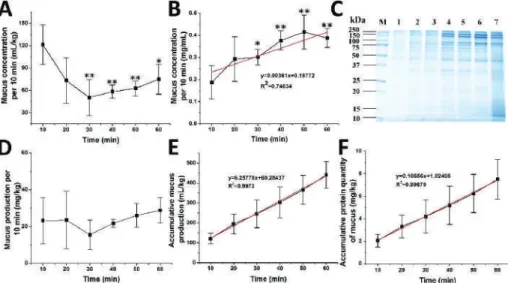
Discussion
- SDS-PAGE
The debris was removed by centrifugation at 4000 rpm for 10 min and the supernatant was collected and stored at -80◦C for further experiments. After mass quantification of the pretreated samples, 60μg of mucus or tissue homogenate was mixed with 5μL of 1 M dithiothreitol (DTT) at 37◦C for 1 hour, and reacted with 20μL of 1 M indoleacetic acid (IAA) in the dark at room temperature for 1 hour. The positive ion mode and the negative ion mode were used separately with the spray voltage of the mass spectrometer at 2000 V.
The precipitate was removed by centrifugation at 4000 rpm for 10 min at 4 °C after shaking the mixture for 1 min. Isotopic interferences were excluded and the absolute peak height threshold was set at 500.
Conclusions
Antioxidant activity of the giant jellyfish Nemopilema nomurais measured by the oxygen radical absorption capacity and hydroxyl radical scavenging capacity methods.Mol. Effects of a toxin from the mucus of the Caribbean sea anemone (Bunodosoma granulifera) on the ionic currents of single ventricular mammalian cardiomyocytes.Toxicon. Proteome reference map of the skin mucus of Atlantic cod (Gadus morhua) revealing immunocompetent molecules. Fish.
Superoxide dismutase multigene family: A comparison of the CuZn-SOD (SOD1), Mn-SOD (SOD2), and EC-SOD (SOD3) gene structures, evolution, and expression. Free Radic Biol. Evolutionary conservation of the antimicrobial function of mucus: A first defense against infection.NPJ Biofilms Microbiomes2018,4, 14.
The Large Jellyfish Rhizostoma luteum as Sustainable a Resource for Antioxidant Properties, Nutraceutical
Results and Discussion 1. Jellyfish Biomass Characterization
Variability in biometric measurements, including FW, FW:diameter ratio, and percent DW values, is representative of different jellyfish growth stages [ 30 ]. 1 were probably attributed to protein and phenolic content, although other unidentified compounds could also be involved [16]. This fatty acid composition shows remarkable differences compared to the other three species previously investigated (see Table 4 in [16]).
In the case of MUFA-oleic acid, (C18:1) is in the same order of magnitude as C. tuberculata and higher than Aureliasp.1 and R. pulmo[16]). Fatty acid composition of Rhizostoma luteum expressed as percentage of total fatty acid ± standard deviation (SD).
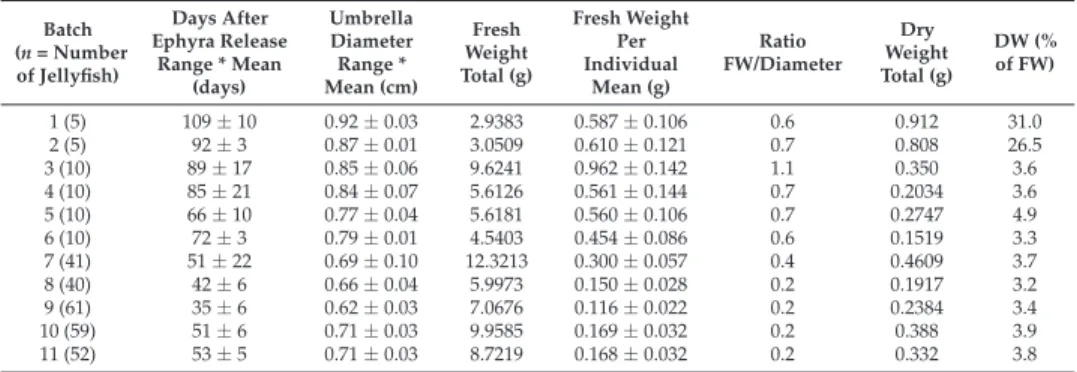
Materials and Methods 1. Materials and Chemicals
Briefly, a solution of the radical cation ABTS+ was prepared by mixing a solution of ABST (2,2'-azinobis(3-ethylbenzothiazoline-6-sulfonic acid) diammonium salt (7 mM) and a solution of potassium persulfate (2.45 mM) in H2O. bulk solvent mixtures were obtained by adding chloroform and water to a final chloroform/methanol/water ratio of 2:2:1.8 (by volume ) to obtain. The potential use of the jellyfish Rhizostoma luteumas biomass, which evaluates their nutritional value and antioxidant properties, has never been evaluated until the present study.
Recent strandings of the giant jellyfish Rhizostoma luteum Quoy and Gaimard, 1827 (Cnidaria: Scyphozoa: Rhizostomeae) on the Atlantic and Mediterranean coasts.Mar. Structural and chemical aspects of the podocyst cuticle of the scyphozoan medusa, Chrysaora quinquecirrha.Biol.
The Anemonia viridis Venom: Coupling Biochemical Purification and RNA-Seq for Translational Research
A. viridis RNA Datasets and Data Mining
The four active toxin motifs for Avi 9a-1 and Avi 9a-2 are indicated by blue arrows. Interestingly, AsKS does not compete with 125I-calcicludin for its binding to rat brain Ca2+ channels up to a concentration of 5 μM [50]. Core members of KVtype V toxins were recently isolated from the venom of the sea anemone Bunodosoma caissaru and showed high affinity for various channels, including KV1.1, KV1.2, KV1.3, KV1.6 and Shaker IR [52].
Similar to AsKS, calicludins do not compete with 125I-calcicludine for its binding to rat brain Ca2+ channels up to a concentration of 5μM. The founding members of KVType 5 toxins were recently isolated from the sea anemone venom B.

From Bioprospecting to Translational Research
Molecular analysis of the sea anemone toxin Av3 reveals selectivity toward insects and demonstrates the heterogeneity of receptor site-3 on voltage-gated Na+ channels. Biochem. APETx1, a novel toxin from the sea anemone Anthopleura elegantissima, blocks voltage-gated human ether-a-go-go-related gene potassium channels. Inhibition of voltage-gated Na(+) currents in sensory neurons by the sea anemone toxin APETx2.Br.
Modulation of Kv3 subfamily potassium currents by the sea anemone toxin BDS: Significance for CNS and biophysical studies.J. Solution structure of APETx1 from the sea anemone Anthopleura elegantissima: A new fold for a HERG toxin.Proteins.
The Jellyfish Rhizostoma pulmo (Cnidaria)
Biochemical Composition of Ovaries and Antibacterial Lysozyme-like Activity of the
Materials and Methods 1. Sample Collection and Preparation
Due to the limited number of unique permutations in the pairwise tests, p-values were obtained from Monte Carlo sampling. Cnidarians as a source of new marine bioactive compounds - An overview of the last decade and future steps for bioprospecting. The fatty acid composition of the common octopus, Octopus vulgaris, in relation to rearing temperature and body weight. Aquaculture.
An evaluation of the antimicrobial properties of the eggs of 11 species of scleractinian corals. Coral reef. Estimation of lipids in marine animals and tissues: Detailed study of the sulfophosphovanillin method for "total" lipids.J.
Jellyfish-Associated Microbiome in the Marine Environment: Exploring Its
Biotechnological Potential
Jellyfish-Associated Microbiome
At the same time, the richness of the bacterial community was approximately the same in all examined life stages. 37] also applied a cultivation approach to investigate the culturable part of the jellyfish-associated microbial community. The culture-independent approach should have described the diversity of the bacterial community associated with C.
Therefore, these conclusions may not be representative of the entire population or jellyfish. One of the main findings of this study was that the gut microbiome of C.
Characteristics of the Jellyfish-Associated Microbiome
The most frequently discovered members of the jellyfish microbiome are associated with the following representatives: Alpha- and Gammaproteobacteria, Bacteroidetes, Tenericutes and Cyanobacteria. Within the jellyfish-associated Alphaproteobacteria, representatives of the families Rhodospirillaceae, Rhodobacteriaceae and Kiloniellaceae and the order Rhizobiales are documented (Table 2). Flavobacteria are therefore an important part of the jellyfish-associated microbiome, as they are widely distributed in jellyfish.
Their frequent detection as part of the jellyfish microbiome suggests that they are important members of the jellyfish-associated microbial consortium. Actinobacteriais a bacterial taxon with the greatest biotechnological potential known [133]. Firmicutes probably also represent a small part of the jellyfish microbiome.
Conclusions and Future Research Directions
This would also suggest a horizontal transfer of the microbiome to the outer body parts of the jellyfish. To the best of our knowledge, no comprehensive study of biotechnological potential of the jellyfish-associated bacteria has been done so far. Stimulated bacterioplankton growth and selection for certain bacterial taxa in the environment of the ctenophoreMnemiopsis leidyi.Front.
Comparative analysis of the ecosystems in the northern Adriatic Sea and the Seto Inland Sea: Can anthropogenic pressure reveal jellyfish outbreaks. Mesogleal cells of the jellyfish Aurelia aurita are involved in the formation of mesogleal fibers. Cell.
Antitumor Anthraquinones from an Easter Island Sea Anemone: Animal or Bacterial Origin?
Results and Discussion 1. Sea Anemone Dereplication
Lupinacidin A (1) and Galvaquinone B (2) have so far only been characterized in actinobacterial representatives, in particular from the genera Streptomyces [24,28] and Micromonospora [25], raising the question of the origin of these compounds in the sea anemone extract. Analysis of the 16S rRNA gene sequences identified ten strains as members of the genera Micromonospora, Streptomyces, Verrucosisspora, Dietzia, Arthrobacter, Rhodococcus and Cellulosimicrobium (Figure 3). The growth yield of the selected Actinobacteria ranged from 20 to 100 mg crude extract.
By comparing chromatograms and retention times, we observed that Lupinacidin A (1) and Galvaquinone B (2) were present only in the crude extract of the sea anemone Gyractis sesere and Verrucosispora sp. The evaluation of the 16S gene showed a high similarity (99%) with the next related type strain, Verrucosispora marisDSM 45365T.
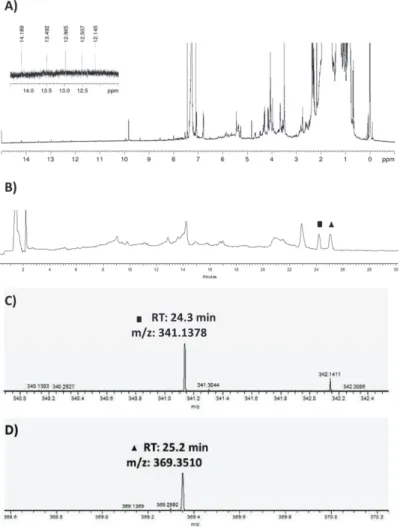
Materials and Methods 1. Sample Collection
For the assessment of secondary metabolite production, we grew the isolated Easter Island strain, Verrucosisporasp. For the evaluation of the metabolites produced, we used HPLC-DAD (Merck Hitachi LaChrom Elite, Darmstadt, Germany) and a 30 min gradient of H2O-acetonitrile supplemented with 0.1% formic acid. The SB™ C-18 gravity column was obtained from Macherey-Nagel (Düren, Germany). Purification of the chemicals involved three different steps: 1) Flash chromatography using standard silica gel 60, pore size ~60 Å (Macherey-Nagel, Düren, Germany) as a stationary phase, mounted in a glass Buchner funnel (D = 70 mm, H = 180 mm).
The chromatographic process was developed in a stepwise increase in polarity (10% each), starting with 100% isooctane and 0% ethyl acetate, and ending in 0% isooctane and 100% ethyl acetate, resulting in 10 different fractions. 2) The fraction containing compound (1) and (2) was selected and processed in HPLC (Merck Hitachi LaChrom Elite, Darmstadt, Germany) using a normal phase NUCLEODUR®100-5 column (4.6 x 250 mm) from Macherey-Nagel (Düren, Germany). A brominated secondary metabolite synthesized by the cyanobacterial symbiont of a marine sponge and accumulation of the crystalline metabolite in the sponge tissue.Mar.
A Multi-screening Evaluation of the Nutritional and Nutraceutical Potential of the Mediterranean Jellyfish
Results 1. Biometrics
Finally in June, both female and male organisms showed similar lengths, bell diameters and masses (p > 0.05) (Figure 1). According to sex samples, female and male jellyfish marked by the asterisk differ significantly for a specific parameter in the same sampling month (p<0.05 according to post hoc Tukey's HSD test). In addition, considering the clock, statistically different energy values were detected between female and male samples (p<0.05).
Same superscript letters in the same row indicate not significantly different values (p > 0.05 by post hoc Tukey's HSD test). Overall, these metals appeared to bioaccumulate mainly in bells than in the respective oral arms (p< 0.05) in the descending order of Na > Mg > Ca≈K, regardless of female and male gender (p> 0.05).


